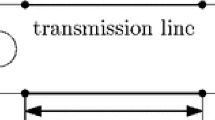The problem of calculating the steady state of an electric power system taking into account the temperature dependence of the resistances in the overhead transmission lines is considered. Two alternative algorithms are proposed. One solves an augmented system of equations by Newton’s method, while the other calculates the resistances separately within the iteration process of solving the equations of the electric state of the power system. The results of a numerical experiment are presented. They validate the algorithms and show a significant increase in the accuracy of determining state variables such as current, voltage, and power loss. The convergence of the algorithms is analyzed compared to each other and to Newton’s method used disregarding the temperature dependence of the resistances.
Similar content being viewed by others
References
V. E. Vorotnitskii and O. V. Turkina, “An estimate of the errors when calculating the varying electric power losses in overhead lines due to neglecting weather conditions,” Power Technol. Eng., 42(6), 359 – 366 (2008).
A. A. Gerasimenko, G. S. Timofeev, and A. V. Tikhonovich, “Allowing for the design, load, and atmospheric factors in calculating the technical losses in distribution networks,” Zh. Sibir. Fed. Univ. Ser. Tekhn. Tekhnol., No. 2, 188 – 206 (2008).
S. S. Girshin et al., “Mathematical model for calculating power losses in insulated conductors with allowance for temperature,” Omsk. Nauchn. Vestn. Ser. Prib. Mash. Tekhnol., No. 3 (83), 176 – 179 (2009).
A. P. Vikharev, “Calculation of admissible currents for the protected wires of 110 kV overhead lines,” Power Technol. Eng., 51(3), 360 – 262 (2017).
Instruction on Calculation and Justification of Standards for Technical Losses of Electric Power Transmitted in Electrical Power Systems at the Ministry of Energy of the Russian Federation [in Russian], Order No. 326 of Ministry for the Power Generating Industry of Russia of December 30, 2008; Bulletin of Federal Agency Regulations No. 16 from 4/20/2009.
O. N. Voitov and E. V. Popova, “Algorithm of allowing for the temperature of a conductor in power flow analysis for an electrical power system,” Élektrichestvo, No. 9, 24 – 30 (2010).
O. N. Voitov, E. V. Popova, and L. V. Semenova, “Algorithms for calculation of current distribution in electrical power systems,” Élektrichestvo, No. 3, 19 – 26 (2013).
J. R. Santos, A. G. Exposito, and F. P. Sanchez, “Assessment of conductor thermal models for grid studies,” IET Gen. Transm. Distr., 1(1), 155 – 161 (2007).
A. O. Shepelev et al., “Mathematical simulation of the electrical state of a closed transmission network with allowance for the temperature dependence of resistances,” Omsk. Nauch. Vestn., No. 4(160), 103 – 109 (2018).
B. I. Ayuev, V. V. Davydov, P. M. Erokhin, and V. G. Neuimin, Computational Models of Power Flow Distribution in Electric Power Systems [in Russian], Flinta – Nauka, Moscow (2008).
E. V. Petrova et al., “Analytic solution to the heat-balance equation for an overhead transmission line conductor in forced convection conditions,” Sovr. Probl. Nauki Obraz., No. 1, 218 (2015).
S. S. Girshin et al. “Simplification of the heat-balance equations of overhead transmission lines in power loss problems,” Omsk. Nauch. Vestn., No. 1(117), 148 – 151 (2013).
State Standard GOST 839–80, with amendments No. 1. Noninsulated Conductors for Overhead Transmission Lines [in Russian], IPK Izd. Standartov, Moscow (2002).
STO 56947007-29.240.55.143–2013. Procedure for Calculating the Limiting Current Loads from the Conductor Strength Requirements and Permissible Dimensions of Overhead Lines [in Russian], PJSC FSK UPS, Moscow (2013).
On Approval of Standards for Power Losses in the Unified National (All-Russian) Power System by the PJSC FGS UES [in Russian], order No. 1251 of the Ministry for the Power Generating Industry of Russia of December 27, 2018. https://minenergo.gov.ru/node/13610
V. I. Tarasov, Basic Theory of the Analysis of Steady States of Electric Pwer Systems [in Russian], Nauka, Novosibirsk (2002).
V. M. Verzhbitskii, Foundations of Numerical Methods [in Russian], Vysshaya Shkola, Moscow (2002).
V. M. Gornshtein (ed.), B. P. Miroshnichenko, A. V. Ponomarev, et al., Methods for Optimization of States of Power Systems [in Russian], Energiya, Moscow (1981).
V. I. Idel’chik, Electric Power Systems and Networks [in Russian], Énergoatomizdat, Moscow (1989).
Author information
Authors and Affiliations
Corresponding author
Additional information
Translated from Élektricheskie Stantsii, No. 11, November 2019, pp. 44 – 54.
Rights and permissions
About this article
Cite this article
Girshin, S.S., Shepelev, A.O. Development of Improved Methods for Calculating Steady States of Power Systems Taking Into Account the Temperature Dependence of the Resistances of the Overhead Transmission Lines. Power Technol Eng 54, 232–241 (2020). https://doi.org/10.1007/s10749-020-01196-w
Published:
Issue Date:
DOI: https://doi.org/10.1007/s10749-020-01196-w



